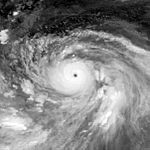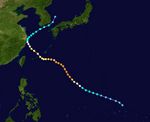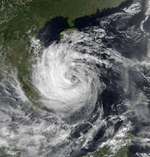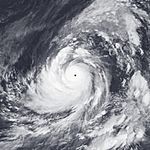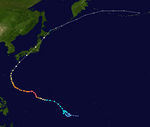1979 Pacific typhoon season facts for kids
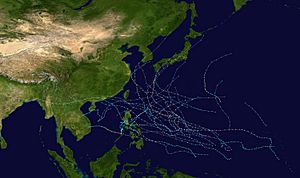 |
|
| Season summary map | |
| First storm formed | January 1, 1979 |
|---|---|
| Last storm dissipated | December 23, 1979 |
| Strongest storm | Tip most intense tropical cyclone ever recorded – 870 hPa (mbar), 305 km/h (190 mph) (1-minute sustained) |
| Total storms | 23 |
| Typhoons | 14 |
| Super typhoons | 4 |
| Total fatalities | Unknown |
| Total damage | Unknown |
| Pacific typhoon seasons 1977, 1978, 1979, 1980, 1981 |
|
The 1979 Pacific typhoon season was a busy year for powerful storms in the western Pacific Ocean. While there are no official start or end dates for a typhoon season, most of these storms usually form between June and December.
In 1979, 28 tropical depressions formed. A tropical depression is like a baby storm, a rotating system of clouds and thunderstorms. Out of these, 23 grew stronger and became tropical storms. Even more impressive, 14 of these tropical storms became typhoons, which are very strong storms, similar to hurricanes in other parts of the world. Four of these typhoons became "super typhoons," meaning they were incredibly powerful.
Contents
What is a Typhoon?
A typhoon is a type of tropical cyclone that forms in the northwestern Pacific Ocean. These storms are huge, rotating systems of clouds and thunderstorms that bring strong winds and heavy rain. They get their energy from warm ocean waters.
- Tropical Depression: The weakest type of tropical cyclone, with winds less than 63 kilometers per hour (39 mph).
- Tropical Storm: Stronger than a depression, with winds between 63 and 118 kilometers per hour (39-73 mph). At this stage, they get a name!
- Typhoon: A very strong tropical cyclone with winds of 119 kilometers per hour (74 mph) or more.
- Super Typhoon: The most powerful typhoons, with winds of at least 240 kilometers per hour (150 mph).
Notable Storms of 1979
The 1979 season had several memorable storms, including some of the strongest ever recorded.
Super Typhoon Hope (Ising)
| Category 4 super typhoon (SSHS) | |||
|---|---|---|---|
|
|||
| Duration | July 25 – August 3 | ||
| Intensity | 240 km/h (150 mph) (1-min), 900 mbar (hPa) | ||
Super Typhoon Hope was a very powerful storm that formed in late July. It reached its strongest point with winds of about 209 kilometers per hour (130 mph). Hope hit Hong Kong on August 2. It caused a lot of damage and sadly led to 112 deaths.
Super Typhoon Judy (Neneng)
| Category 4 super typhoon (SSHS) | |||
|---|---|---|---|
|
|||
| Duration | August 16 – August 26 | ||
| Intensity | 250 km/h (155 mph) (1-min), 887 mbar (hPa) | ||
Super Typhoon Judy was another incredibly strong storm in August. It reached peak winds of about 217 kilometers per hour (135 mph). Its central pressure dropped to 887 millibars, which is a very low pressure, showing how intense the storm was.
Typhoon Sarah (Trining-Uring)
| Category 3 typhoon (SSHS) | |||
|---|---|---|---|
|
|||
| Duration | October 4 – October 15 | ||
| Intensity | 205 km/h (125 mph) (1-min), 929 mbar (hPa) | ||
Typhoon Sarah formed in early October and grew into a strong tropical cyclone. It had winds of about 177 kilometers per hour (110 mph). Sarah later moved towards Vietnam, causing many deaths and damaging important crops.
Super Typhoon Tip (Warling)
| Category 5 super typhoon (SSHS) | |||
|---|---|---|---|
|
|||
| Duration | October 4 – October 19 | ||
| Intensity | 305 km/h (190 mph) (1-min), 870 mbar (hPa) | ||
Typhoon Tip was the most powerful tropical cyclone ever recorded anywhere in the world. It formed on October 4 and became a super typhoon. At its strongest, Tip had incredible winds of about 266 kilometers per hour (165 mph). Its central pressure dropped to an astonishing 870 millibars, which is the lowest pressure ever measured in a tropical cyclone.
Super Typhoon Vera (Yayang)
| Category 5 super typhoon (SSHS) | |||
|---|---|---|---|
|
|||
| Duration | November 2 – November 7 | ||
| Intensity | 260 km/h (160 mph) (1-min), 915 mbar (hPa) | ||
Super Typhoon Vera was another very strong storm that developed in November. It reached winds of about 225 kilometers per hour (140 mph). Vera was one of the four super typhoons of the 1979 season, showing the extreme power these storms can have.
Naming Storms
Tropical cyclones in the Western North Pacific are given names by the Joint Typhoon Warning Center. This helps people track and talk about the storms more easily. The first storm of 1979 was named Alice, and the last one was named Ben.
Sometimes, if a storm causes a lot of damage or deaths, its name is "retired." This means the name won't be used again for another storm. The name Alice was retired after the 1979 season and was replaced by the name Andy for future storms.


